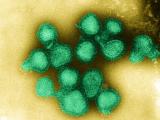Apr 20, 2012 (CIDRAP News) – Flu activity in the United States continued a steady retreat last week, a pattern echoed by surveillance markers in Europe, health officials said today in their influenza updates.
The flu season got an unusually late start this year in both the United States and Europe, and experts at the US Centers for Disease Control and Prevention (CDC) have said flu activity could last for weeks to come.
The CDC reported that nearly all flu markers decreased last week, including the percentage of respiratory specimens that tested positive for flu, which dropped from 21% to 17.5%.
Nationally, the percentage of doctor visits for flulike illness held steady at 1.5%, though the percentage for one of the CDC's regions—the one that includes Alaska, Idaho, Oregon, and Washington—was above the area-specific baseline for the second week in a row.
Two more pediatric flu deaths were reported, raising the season's total to 15. One of the deaths involved the 2009 H1N1 virus, and the other was linked to H3N2. Overall deaths from pneumonia and flu fell from 7.5% to 7.0%, putting this marker below the seasonal baseline.
During virus testing for susceptibility to antiviral drugs oseltamivir and zanamivir, all remained susceptible, except for a limited number of 2009 H1N1 viruses. Six additional samples showed resistance to oseltamivir, raising the season's total to 13.
Six states reported widespread geographic spread of flu last week, representing a decrease of four from the previous week.
Last week the CDC said sporadic flu activity in the United States included outbreaks in nursing homes, where residents are routinely vaccinated, and other institutionsIsolated media accounts have reported them as well, along with suspicions that the outbreaks were sparked by different or drifted flu strains.
For example, on Apr 16 the Associated Press (AP) reported on an influenza outbreak at a veteran's home in Rocky Hill, Conn., that led to the hospitalization of 18 patients. Yesterday, the Hartford Courant reported that testing at Connecticut's state lab showed that the virus responsible for the now-24 hospitalizations was the H3N2 strain targeted by this year's seasonal flu vaccine.
Joe Breese, MD, chief of the CDC's Influenza Epidemiology and Prevention Branch, told CIDRAP News that the seasonality of nursing home outbreaks isn't fully understood, and that the outbreaks probably follow the same time distribution as general flu activity. He said that as the flu season winds down this time of year, nursing home outbreaks might be the kind of flu stories reported.
Another factor in nursing home outbreaks is that vaccine-induced antibodies can wane over time, leaving patients who were immunized against flu early in the season with less protection later in the season, he said. Breese noted that older people have a poorer response to flu vaccination in the first place, so they may be at a greater disadvantage as immune response tapers off.
Outbreaks are occasionally linked to drifted strains, but Breese said the CDC hasn't noted anything unusual about recent nursing home outbreaks: the same strains predominant in the community are responsible for the institutional outbreaks.
Meanwhile, an analysis of influenza trends in Europe suggests that activity continues to fade across the continent, the European Center for Disease Prevention and Control (ECDC) said today. Flu activity has peaked in several countries, and the percentage of respiratory specimens testing positive for flu declined to 29.1%, the seventh consecutive drop from a peak of 60%, according to the flu update.
Virologic surveillance suggests that the proportion of influenza B viruses has risen steadily and now accounts for about one-third of the circulating viruses, which is not surprising late in the season, the ECDC said.
See also:
Apr 20 CDC flu update
Apr 16 AP story
Apr 19 Courant story
Apr 20 ECDC flu update




















